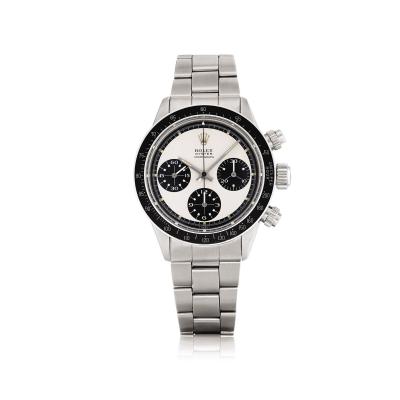
Posted in: Designer Spotlights, Auctions/Results
 Rolex 'Paul Newman' Daytona Cosmograph, circa 1966. Photo courtesy of Sotheby's.
The watch featured above, the 'Paul Newman' Rolex Daytona Cosmograph (circa 1966), sold at Sotheby's for an astonishing price of $188,878. Not surprisingly, Rolex watches continue to perform well at auction. This past week, Sotheby's auctioned this and 77 more in their Important Watches sale. Of these 78 elite watches, 63 sold for a grand total of just over $4 million.
Rolex 'Paul Newman' Daytona Cosmograph, circa 1966. Photo courtesy of Sotheby's.
The watch featured above, the 'Paul Newman' Rolex Daytona Cosmograph (circa 1966), sold at Sotheby's for an astonishing price of $188,878. Not surprisingly, Rolex watches continue to perform well at auction. This past week, Sotheby's auctioned this and 77 more in their Important Watches sale. Of these 78 elite watches, 63 sold for a grand total of just over $4 million.
The Rolex Daytona
Launched in 1963, Rolex designed the Daytona Cosmograph as the ideal tool for endurance racing drivers. First of all, it was robust, designed in stainless steel with their Jubilee band with a folding clasp. Most important, it featured a tachymetric scale on the bezel which allowed a driver to calculate their average racing speed with the push of a button. With three counters, the Rolex Daytona enabled a driver to track elapsed time in hours and minutes, as well as average speed to within 1/8 of a second accuracy.An Elite Class
This featured Rolex Daytona belongs to an elite class of Daytona watches. Released among the earliest batches of Daytonas, it features the rare Daytona Jumbo dial. The Jubilee Bracelet further enhances the vintage of this design. The newer Daytonas feature the Oyster Bracelet, made of Rolex's exclusive Oystersteel alloy. Time and oxygen have also weathered the subsidiary registers, rendering them a beautiful tobacco brown which contrasts nicely with the stark white background. Rolex debuted dial configuration reference 6240, featured in this Daytona watch, in 1966. They produced it for the Daytona watches for only three years. Subsequent batches featured reference 6263 and 6265. In addition to the vintage of this model, these unique features impart a rarity to what is already a collector's watch. Today, the Rolex Daytona continues to command respect, particularly at America's most prestigious speedways.Modern Daytona
Today's Daytona wristwatches continue to provide important and accurate information to racecar drivers. Belonging to Rolex's class of Professional Watches, the company describes the Daytona as "A Watch Born to Race." Now made with 904L steel alloy, these watches can withstand all the pressures of the raceway without missing a tick. Rolex commandeered this special steel for watchmaking from the aerospace and chemical industries in 1985. In 2000, the engineers at Rolex designed a special chronograph, the Caliber 4130, comprised of only 290 components, which employs a vertical clutch activator. This offers absolute precision in stopping and starting when the pusher is pressed. Clearly, this attention to detail and precision opened the doors for a partnership between Rolex and the racing industry. Rolex is now the Official Timepiece of the Daytona Internati, as well as for Formula 1.Daytona Beach
According to its designers, the Daytona Cosmograph, of course, conjures its namesake. Founded in 1870, Daytona Beach became famous for its smooth, wide beaches. These long stretches of hard-packed sands inspired motor car races in the early 1900s. In the 1930s, the racing industry devised road courses for stock cars. In 1959, just four years before Rolex designed a watch for race car drivers, US race car driver Bill France built the International Speedway. Since then, thousands of racing enthusiasts continue to flock to Daytona Beach annually for the Daytona 500.6 years ago
1 view(s) 